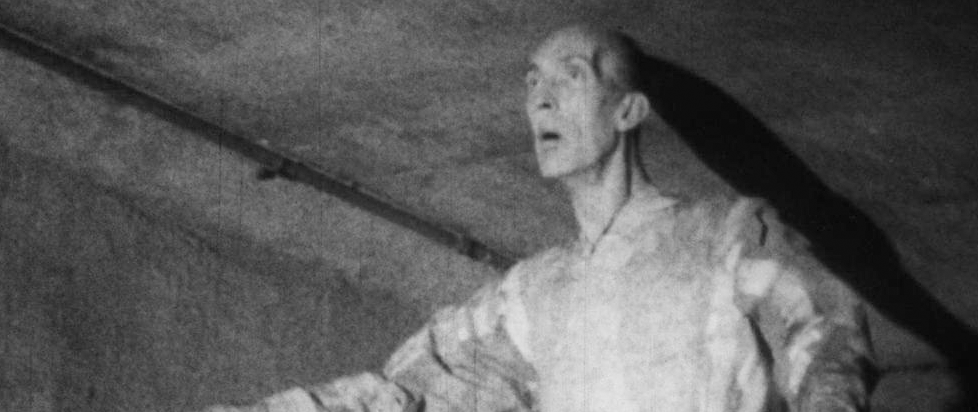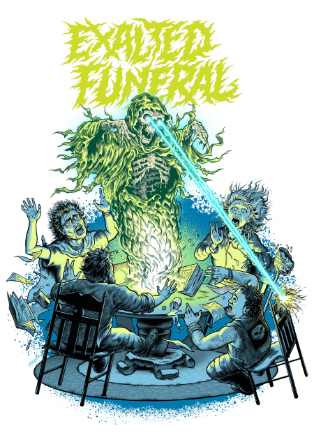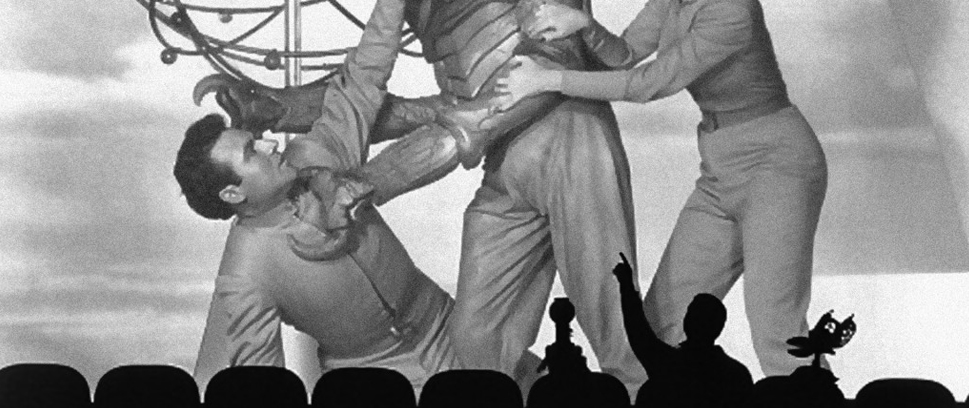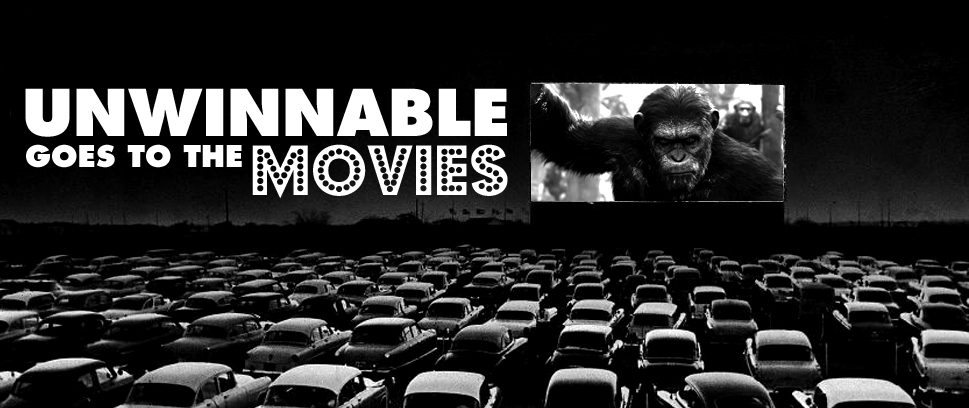
I Created It as I Went Along: Bill Rebane’s Weird Wisconsin Box Set from Arrow Video
Prior to sitting down with this substantial Blu-ray set, which contains just over half of the feature-length films for whom Bill Rebane is the credited director, the full and complete extent of my knowledge of his filmography came from Mystery Science Theater 3000, where a handful of his films had been featured. That’s rarely an encouraging place to start from, but in the case of Rebane’s notoriously eccentric output, it at least feels like an appropriate one.
“This is the ‘a go-go’ part.” – the ‘Bots from MST3K re: Monster a Go-Go (1965)
Plenty of ink has been spilled over the years speculating on the identity of the worst movie that Mystery Science Theater 3000 ever covered. While the most popular answer is usually Manos: The Hands of Fate, I would suggest that a good contender for that “honor” is this flick, which was cobbled together by none other than the “Godfather of Gore” himself, Herschell Gordon Lewis, using footage left over from several abortive attempts by Bill Rebane at stringing a feature debut together. In fact, Rebane himself has reportedly declared the finished product the “worst movie ever made.”
Is that a little harsh? Almost certainly. But while the version included on Blu-ray in this set may look and sound at least a little better than the one lambasted by Joel and the ‘Bots all those years ago, it’s still a far cry from a cinematic masterpiece. And while we’re unlikely to find a cinematic masterpiece in a boxed set celebrating a director whose greatest exposure probably came via being featured on MST3K, it’s still unfortunate for Rebane that this set (and his career) starts off with Monster a Go-Go, since it is never the movie it was intended to be.
Rebane got his start in features trying to make a “Twilight Zone style” movie that was originally going to be called S. When that stalled, he moved on to a project called Terror at Half Day, named for a now-extinct neighborhood in Chicago. It wasn’t long, however, before everything that could possibly go wrong on a first feature, did. The result is not just multiple reshoots cobbled together into a disjointed mess – with actors disappearing and reappearing in the film, once a deceased character’s heretofore-unmentioned twin brother – but a movie that was never actually completed by its original director.
When Lewis bought the footage of Terror at Half Day and hung with a(n admittedly much catchier) alternate title and taglines like, “The picture that comes complete with a 10-foot-tall monster, to give you the wim-wams,” it may have been the best thing to happen to the movie, but it would also have been enough to prompt many other first-time directors to throw in the towel.
If there’s one thing that we learn about Rebane from this boxed set, however, it’s that he’s anything but easily discouraged, and in a filmography filled with head scratching decisions and movies that are defined as much by the adversity under which they were made as by their extremely limited budgets, maybe Monster a Go-Go is the perfect way to kick things off…
“What’s so hard about believing that we’re not the only ones in this universe?” – Invasion from Inner Earth (1974)
Despite what I just said about Rebane not being easily discouraged, more than a decade separates the troubled production of his first feature and Invasion from Inner Earth, arguably the first actual movie in this set. During that time, Rebane made his living on everything from short films and industrial videos (one of which is included in the special features of this set) to a documentary about the missing arms of the Venus De Milo.
By the time he finally did get back to making features, he had already acquired his 200-acre “shooting ranch” in Wisconsin, and begun to accumulate the traits that would define the rest of his cinematic output, beginning with Invasion from Inner Earth, which is basically the movie you would get if Night of the Living Dead (or, more accurately, War of the Worlds) only followed characters who were nowhere near anything that ever happened.
Those “traits” I mentioned include both good and bad aspects. The regionalism that many point to as the most obvious pleasure of Rebane’s filmography is already firmly in place in this snowy and sedate (inner) space invasion flick, along with a resolute commitment to earnest speculation about absolutely off-the-rails “science,” such as a particularly great monologue about a giant rose devouring most of the eastern seaboard before blotting out the sun. Of course, they bring with them many not so great aspects, like extraordinarily meager budgets, utterly baffling story decisions, and sound mixing that renders much of the dialogue all-but incomprehensible.
As with Monster a Go-Go before it and Giant Spider Invasion (the other MST alum) after, Invasion from Inner Earth’s ambitions outstrip its budget by a considerable margin. Indeed, its ideas are, at times, as ambitious as they come. Did you know, for example, that a long time ago, Mars go closer to Earth than the moon is and stayed that way for thousands of years? Did you know that this is why the Martians had to abandon their planet and move to the center of the Hollow Earth? It’s apparently fairly common knowledge, so I’m surprised you haven’t heard about it…
Of course, with the exception of a couple of pretty decent no-budget UFO shots, Invasion from Inner Earth can’t actually show any of this, so the “action,” such as it is, is relegated to four people sitting around in a cabin and arguing, occasionally broken up by charmingly low-rent sequences of fake newscasts or shots of people running in the streets, fleeing what look to be large smoke bombs.
It almost works some of the time, in spite of all that, even if it is also quite boring. It’s much better when viewed as a proof-of-concept for the superior Alpha Incident, which would follow it some four years later and on the next disc in this set, and you certainly can’t fault it for not taking a big swing, anyway…
“Can you call it an ‘incident’ when nothing happens?” – someone on Letterboxd re: The Alpha Incident (1978)
Bill Rebane made the MST3K “classic” Giant Spider Invasion in-between Invasion from Inner Earth and this flick, but that movie (like several other titles in his weirdo filmography) isn’t included in this set, which means that we’re watching this and Inner Earth back-to-back, which goes a long way toward reinforcing how much this feels like an attempt, on Rebane’s part, to actually pull off what he was going for in Inner Earth – and he mostly succeeds!
Apparently, this is Rebane’s favorite from among all of the movies he made and, honestly, it’s easy to see why. It’s probably his best. Sure, the scenes of the scientists talking amongst themselves have all the energy (for good or ill) of The Incredible Melting Man – another MST3K alum that isn’t by Rebane, but the same spirit is certainly there – but Rebane handles the plot of an alien force threatening the world while a handful of people are trapped in a single location where nothing much actually happens much better this time, in part by putting our protagonists at immediate risk from an invisible (and therefore budget-friendly) threat: they’ve all been exposed to an alien pathogen that will cause them to die gruesomely if they fall asleep.
(It’s basically the only special effect in the entire movie, but it’s surely a doozy when it finally does show up.)
The Alpha Incident is helped along by a tighter screenplay and actual actors, especially reliable character actor and movie drunk George “Buck” Flower, who may be the first one of our limited cast to kick the bucket, but who also milks the most pathos out of his part before he goes. Perhaps no other actor of his era could have quite so successfully sold both the comic relief drunk and the man coming undone by guilt over having inadvertently infected the people around him with an alien virus quite like ol’ Buck.
It’s also nihilistic in that late-‘70s sort of way; claustrophobic and paranoid, weaponizing the very tedium of its central premise in a way that Inner Earth’s different logline wouldn’t allow. None of which is to say that this is necessarily an A+ effort, by normal metrics, but I can absolutely see why Rebane was proud of it – and I think he was right to be.
“Town’s dead.” – The Demons of Ludlow (1983)
What do you do when you want to remake John Carpenter’s The Fog but you don’t have any fog or any budget but you do have a snowy Wisconsin ghost town, some Colonial-era costumes, and a piano? If you’re Bill Rebane and his crew of locals and regulars, you make The Demons of Ludlow!
Of all the flicks in this set, this was the one I was most excited about watching, in part because I like haunted pianos better than alien invasions or whatever the hell the next few movies are going to be about. In fact, I like haunted pianos better than most stuff, and if anyone had told me what an obvious riff on The Fog this was – complete with actual story beats getting straight lifted – I would have been even more excited.
And, to my own surprise, I wasn’t let down. Again, Demons of Ludlow is no Fog, but no one ever expected it to be, probably not even Bill Rebane. What it is, instead, is its own local, low budget, lo-fi, weirdo thing. If The Alpha Incident was maybe Rebane’s best picture, this might be the first one where all the pieces finally actually come together. For the first time, the movie’s ambitions don’t outstrip its budget or the talents of the cast and crew, even though Demons of Ludlow has less star power than Alpha Incident did.
Where that flick was subdued this one … is also subdued, let’s be honest, but when it is bonkers, it really commits. There are bloodied hands flickering with optical effect lightning, and the ghostly assaults are low rent but effective, complete with plenty of people in pancake makeup and Colonial wigs licking their lips lasciviously and reaching out bloody hands toward the various (often scantily-clad) townsfolk.
Does it make a lot of sense? Not really, no, though more than the next couple of films in this set are going to. But was that ever really the point? The answer to that is also “no.”
“Quite confusing is this story as the tale comes to a close.” – The Game (1984)
Between The Alpha Incident and Demons of Ludlow, this set skipped five years and two flicks, including one that I’m really bummed about because just look at that key art, or that other key art! Oh well, I guess I’ll just have to wait and watch Croaked: Frog Monster from Hell some other time.
Such is not the case between Demons and The Game, which were released just a year apart. As the (hardcover) booklet that accompanies the set points out, these two films and his Tiny Tim-starring 1987 slasher Blood Harvest are also Rebane’s only “straight” horror movies, if any of those can truly be considered straight anything. With most of his others, he’s at least as interested in the science fiction premises (however outlandish or unscientific) as he is in the horror, usually more so.
Of those three, I haven’t seen Blood Harvest, because it’s not in this set, but I feel like I can still safely say that The Game is the one least interested in being a horror flick. Instead, it seems more like Rebane’s riff on something like House on Haunted Hill, by way of something like April Fool’s Day. Which is to say that it’s less about fear than about setting up gags, continuity or logic be damned.
If you were to do one of those word graph things with all the reviews of The Game on Letterboxd, I’m pretty sure the word that came up the most would be “nonsense.” And they’re not wrong. While the premise is straightforward enough – three eccentric millionaires invite a handful of guests to an abandoned resort to play a “game” in which they have to confront their fears – the unspooling of said events rarely makes much sense, which even the film’s own narration acknowledges.
The booklet calls it “a satire of ‘mystery plotting’ itself,” though “nonsense” is just as good a term. The Game is nonetheless great fun much of the time, and its most effective element is certainly its three sadistic millionaires, who have a ball creeping around the hallways in scary masks, egging each other on, and getting drunk and singing “Jimmy Crack Corn.”
“This plan cannot fail.” – Twister’s Revenge (1987)
Never has a movie from 1987 felt more like a movie from 1978 than Bill Rebane’s final directorial feature, Twister’s Revenge, which also closes out this boxed set as the only non-horror-adjacent movie in the bunch. Indeed, its only nod toward a speculative element is the (unnecessarily) AI-powered talking monster truck from which it derives its name.
In structure, Twister’s Revenge feels like one of those early live-action Disney movies in which a gang of bickering and bumbling crooks are thwarted by children, pets, or, in this case, a talking monster truck, even if the humor is more sexual and scatological than those flicks would have allowed, and they probably wouldn’t have featured a complete musical number by a random local burlesque act.
“This whole film was shot without a screenplay,” Rebane is quoted as saying in the booklet that accompanies the Arrow Video set. “Every morning we would take the cast and say, ‘What are we going to do today?’” It’d be tempting to say that it shows, but honestly, while Twister’s Revenge is often jarring and baffling, it’s never really more so than many of Rebane’s better and more serious flicks, from the head-scratching ending of Invasion from Inner Earth to the utter nonsense of The Game.
Even Rebane’s staunchest advocates generally seem to argue that one of the biggest selling points of his wide array of indie pictures is their regionalism. In many ways, Rebane can be seen as one of the kings of the regional genre movie, and most of the flicks in this set were filmed at his “shooting ranch” in rural Wisconsin.
That regionalism certainly is a strength of these films and, perhaps surprisingly, not the only one. Yet, Weird Wisconsin is unlikely to bring many new converts to the church of Bill Rebane. If you get to the end of the six films contained here and feel the need for even more Rebane, however, the set also comes with a feature-length documentary on the filmmaker, not to mention the aforementioned hardcover booklet, both of which are probably of interest to aficionados of independent and regional cinema, even if you aren’t a fan of the filmmaker.





